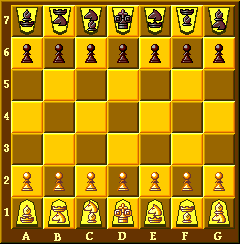Loonybird
In 1983, Dutch games inventor Christian Freeling invented this game. (For information how and when, look to his description on the website of Christian Freeling and Ed van Zon: Mindsports.)
Rules
The game is played on a seven by seven board. Each player has a king, a rook-bishop, a knight-rook, a bishop-knight, a rook-knight, a bishop-rook, a knight-bishop, and seven pawns. Each piece, except the kings moves differently when taking and when not taking. To be more specific, a piece is considered to be of two parts: a hunter part (the top part in the diagram), and the carrier part (the bottom part in the diagram). When a piece makes a move without taking, it moves as in its carrier part; when a piece moves with taking, it moves as in its hunter part. Thus, a rook-bishop moves without taking like a rook, and takes like a bishop, etc.
 White:
White:
King d1; rook-bishop a1; knight-rook b1; bishop-knight c1; rook-knight
e1; bishop-rook f1; knight-bishop g1; pawns a2, b2, c2, d2, e2, f2, g2.
Black:
King d7; rook-bishop a7; knight-rook b7; bishop-knight c7; rook-knight
e7; bishop-rook f7; knight-bishop g7; pawns a6, b6, c6, d6, e6, f6, g6.
When a piece, but not a pawn, is taken from the opponent, the player that took the piece gets it `in hand'. The piece changes color, and the player can, instead of making a normal move, drop the piece on an empty square when he wishes. (This is as in Shogi, and for this reason, pieces are shown in their wedge-form - the direction the wedge is pointing from gives the player that owns the piece.) Pawns disappear from the game when they are captured.
Pawns and kings move as in orthodox chess, but pawns do not have a double initial step. When a pawn reaches the last row, it can promote to a piece the opponent has in hand. Kings can castle with the rook-bishop on a1 (for white) and a7 (for black), under the usual conditions; in particular, a dropped rook is considered to have moved. When castling, the king goes to b1 or b7, respectively, while the white rook-bishop can go to c1 or d1 (white's choice), and black can choose between c7 and d7 for the position of his rook-bishop after castling.
Comment
A related game (with somewhat more `orthodox' rules) by the same inventor, and invented about at the same time is Dragonfly.
Image copyright Mindsports, used here with permission. For more information on this and other games by Christian Freeling, see the Mindsports website. Text written by Hans Bodlaender.
WWW page created: March 23, 1998. Last updated: January 23, 2005.
